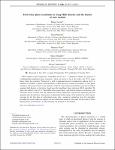First-order phase transitions in Yang-Mills theories and the density of state method
| dc.contributor.author | Lucini, B | |
| dc.contributor.author | Mason, D | |
| dc.contributor.author | Piai, M | |
| dc.contributor.author | Rinaldi, E | |
| dc.contributor.author | Vadacchino, D | |
| dc.date.accessioned | 2024-03-15T09:19:17Z | |
| dc.date.available | 2024-03-15T09:19:17Z | |
| dc.date.issued | 2023-10-23 | |
| dc.identifier.issn | 2470-0010 | |
| dc.identifier.issn | 2470-0029 | |
| dc.identifier.other | 074517 | |
| dc.identifier.uri | https://pearl.plymouth.ac.uk/handle/10026.1/22180 | |
| dc.description.abstract |
When studied at finite temperature, Yang-Mills theories in 3+1 dimensions display the presence of confinement/deconfinement phase transitions, which are known to be of first order - the SU(2) gauge theory being the exception. Theoretical as well as phenomenological considerations indicate that it is essential to establish a precise characterization of these physical systems in proximity of such phase transitions. We present and test a new method to study the critical region of parameter space in non-Abelian quantum field theories on the lattice, based upon the logarithmic linear relaxation (LLR) algorithm. We apply this method to the SU(3) Yang-Mills lattice gauge theory, and perform extensive calculations with one fixed choice of lattice size. We identify the critical temperature, and measure interesting physical quantities near the transition. Among them, we determine the free energy of the model in the critical region, exposing for the first time its multivalued nature with a numerical calculation from first principles, providing this novel evidence in support of a first-order phase transition. This study sets the stage for future high-precision measurements, by demonstrating the potential of the method. | |
| dc.format.extent | 074517- | |
| dc.language | en | |
| dc.publisher | American Physical Society (APS) | |
| dc.subject | 5106 Nuclear and Plasma Physics | |
| dc.subject | 5107 Particle and High Energy Physics | |
| dc.subject | 4902 Mathematical Physics | |
| dc.subject | 49 Mathematical Sciences | |
| dc.subject | 51 Physical Sciences | |
| dc.title | First-order phase transitions in Yang-Mills theories and the density of state method | |
| dc.type | journal-article | |
| dc.type | Article | |
| plymouth.issue | 7 | |
| plymouth.volume | 108 | |
| plymouth.publication-status | Published online | |
| plymouth.journal | Physical Review D | |
| dc.identifier.doi | 10.1103/physrevd.108.074517 | |
| plymouth.organisational-group | |Plymouth | |
| plymouth.organisational-group | |Plymouth|Faculty of Science and Engineering | |
| plymouth.organisational-group | |Plymouth|Faculty of Science and Engineering|School of Engineering, Computing and Mathematics | |
| plymouth.organisational-group | |Plymouth|REF 2021 Researchers by UoA | |
| plymouth.organisational-group | |Plymouth|Users by role | |
| plymouth.organisational-group | |Plymouth|Users by role|Academics | |
| plymouth.organisational-group | |Plymouth|REF 2021 Researchers by UoA|UoA10 Mathematical Sciences | |
| plymouth.organisational-group | |Plymouth|REF 2021 Researchers by UoA|ZZZ Extended UoA 10 - Mathematical Sciences | |
| plymouth.organisational-group | |Plymouth|REF 2029 Researchers by UoA | |
| plymouth.organisational-group | |Plymouth|REF 2029 Researchers by UoA|UoA10 Mathematical Sciences | |
| dcterms.dateAccepted | 2023-09-20 | |
| dc.date.updated | 2024-03-15T09:19:16Z | |
| dc.rights.embargodate | 2024-3-20 | |
| dc.identifier.eissn | 2470-0029 | |
| rioxxterms.versionofrecord | 10.1103/physrevd.108.074517 |


